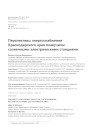Climate, the role of fuels and renewable energy sources
DOI: 10.33917/mic-3.104.2022.28-37
In 2021, the cost of building solar panels has risen in price by 50%, and wind power plants (WPP) by 13%. Many experts write about their further significant growth. This is also noted in The Global Risks Report 2022 at the World Economic Forum (WEF) in Davos in 2022. Thus, the price of polysilicon over the past year has increased by about 3 times, the price of hot-rolled steel has doubled. Steel production is a process with a high share of CO2 emissions. The era of relatively inexpensive renewable energy is over.
In the coming years, the failure of the climate action of the «green transformation», the growth of fuel consumption, energy and economic crises are coming.
References:
1. «The Global Risks Report 2022» // World Economic Forum. Davos. January 2022.
2. Losev A. Saving the climate: Plan B. Kommersant, February 24, 2022.
3. Patrikeyeva K. Discontinuous course. Kommersant, March 10, 2022.
4. Nigmatullin R. How long will «green» gas be relevant. Moskovsky Komsomolets, March 2, 2022. P. 6.
5. Woodpecker T., Smertina P. Business asks for energetic measures. Kommersant, February 24, 2022.
6. Renewable power generation costs in 2019. International Renewable Energy Agency, 2020.
7. Manukov S. The era of cheap renewable energy sources has come to an end. URL: Expert.ru, January 26, 2022.
8. Decree of the President of the Russian Federation dated March 31, 2022 No. 172 «On a special procedure for the fulfillment by foreign buyers of obligations to Russian suppliers of natural gas». – Access from legal reference system ConsultantPlus.
















